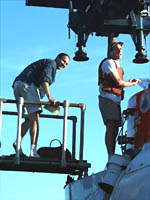

TODAY'S WEATHER
Sunny
68°F
(20°C)
Latitude: 27deg 0’ N
Longitude: 111deg 24’ W
Wind Direction: WNW
Wind Speed: 12 Knots
Sea State: 1
Swell(s) Height: 2 Feet
Sea Temperature: 64°F (17.8°C)
Barometric Pressure: 1014.8 MB
Visibility: 20 Nautical Miles

BREAKFAST
Scrambled eggs
Sausage
Ham
Pancakes
Oatmeal
Fresh fruit
LUNCH
Vegetable bean soup
Kielbasa sausage and sauerkraut roll
Turkey noodle casserole
Cheese quiche
Salad bar
Three Musketeers frozen bars
DINNER
Baked sea scallops
Chicken Marsala
Saffron rice
Creamed spinach
Yellow squash with snow peas
Cornflour bread
Salad bar
Chocolate mousse with whipped cream

Pilot in Training Phil Forte prepares to enter Alvin while Steve Faluotico,
the Launch Coordinator for the dive checks the A-frame.

Phil Taylor climbs down the rope ladder from Atlantis to board the “Rambler” to
return to Guaymas.
Daily Update: Dive
3521
January
18, 2000
By Dr. Dan Fornari and Dr. Susan Humphris
It was another balmy day on the
Sea of Cortez. Alvin Dive 3521 was launched at 0805 hrs.
Pilot-in-Training Phil Forte was at the controls. Expedition Leader
Pat Hickey went along to help Phil with his training. Phil, a mechanical
engineer by training, has been a member of the Alvin Group
for about a year. He hopes to complete his pilot training this
year. Scientist George Luther also went along. His highest priority
was collecting sediment cores.
While Alvin was diving, we had a visit from the Rambler,
a 38-foot fishing boat captained by Mr. Rusty Price of Guaymas,
Mexico, and Seattle, Wash.
He had kindly agreed to pick up Dr. Phil Taylor who needed to get
back to his office at the National Science Foundation. Mr. Price
and the crew from the fishing boat toured the ship for an hour and
talked with the scientists, crew, and Captain Silva. Before heading
back to Guaymas, they gave us about 20 pounds of yellow tail they
had caught the day before. Carl Wood, the steward, will prepare it
for dinner in the next few days.
This afternoon, we (Susan and Dan) and Craig Cary finally succeeded in recording
whale sounds. With Ken Rand, a member of the ship's crew, piloting the Avon,
we motored about two miles west of the ship towards the shore. There we came
upon a pod of pilot whales and a school of dolphins. We lowered the hydrophone
into the water and recorded the whistles made by the pilot whales. Meanwhile, Ken recounted some experiences
he had had last year while sailing single-handedly across the North Atlantic
from Halifax, Nova Scotia, to Gibraltar. One night he woke up to the sound of
blowing. Several sperm whales had surrounded him.
Tim Rozan, Liz McCliment, and Brian Glazer have been trying to figure the best
way to collect sediment cores so that they can make the chemical measurements
they need. Prior to today's dive, they looked at videos of previous dives and
talked with the Alvin pilots about how best to collect cores without
stirring up the the layers of mud in the cores. As is the case with a lot of
science, careful planning and good communication paid off. George, Phil, and
Pat collected some of the best cores of the cruise. Armed with electrodes,
the scientists are now poking and prodding the cores, trying to reveal the
cores’ chemistry.
Dive Summary
On Bottom: 0915 hrs
Off Bottom: 1534 hrs
Maximum Depth: 2007 meters
The main objectives of today’s dive were to collect additional sediment
cores and bring up more tubeworms for genetic and biological analyses. Phil Forte,
the pilot-in-training, and observers Pat Hickey and George Luther collected five
core and “Sipper” samples from three of the vent sites that
had been explored several times previously. They also made chemical scanner
profiles of hot vents and lower-temperature diffuse flows. Finally, they
brought back about a dozen tubeworms; some of which were almost two meters
(about six feet) long. The biologists are now in the lab dissecting the
tubeworms and processing the tubeworm tissues. See yesterday's (Jan. 17)
daily report for details on what the biologists are doing with the tubeworms.
|





